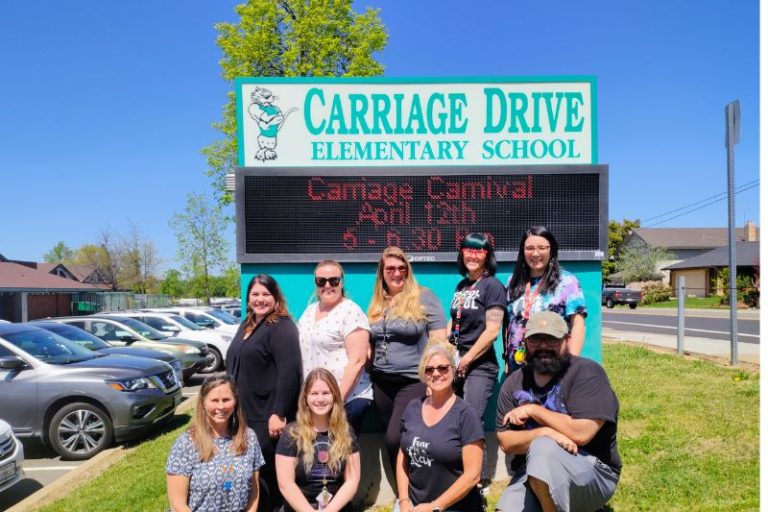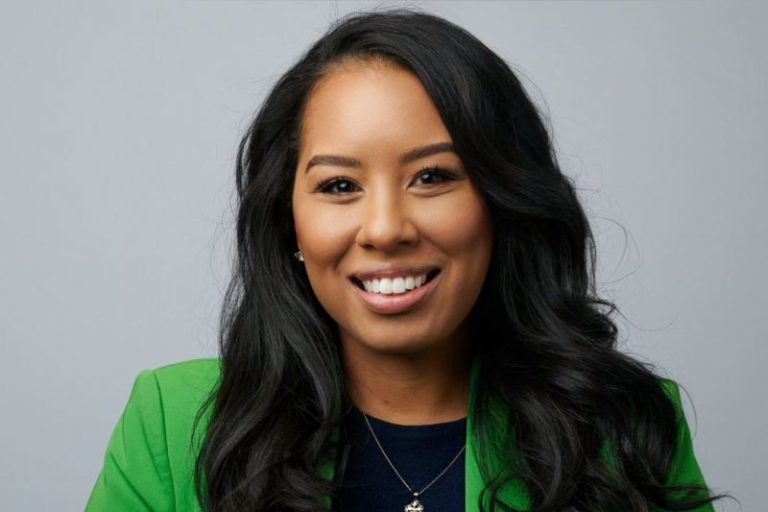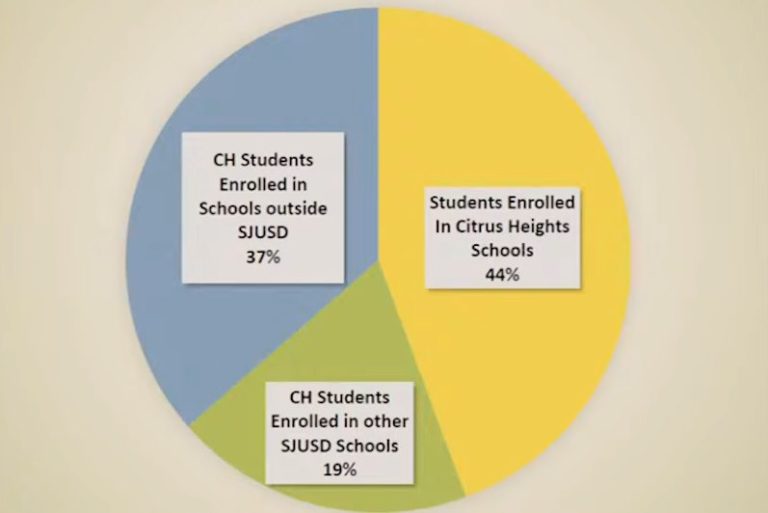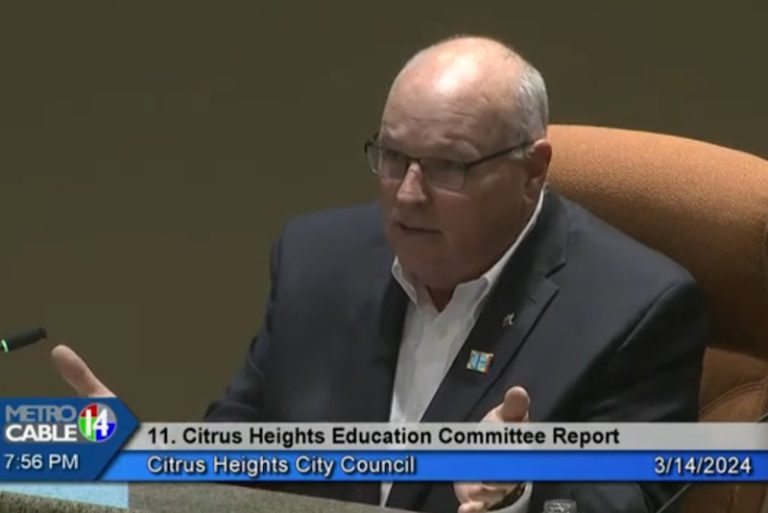
Sentinel staff report–
Citrus Heights has long been criticized for having under-performing schools operated by the San Juan Unified School District, which has City leaders concerned that young families won’t be attracted to move to the area and has also led to parents finding ways to send their children to schools outside the city limits.
Charter schools have been suggested as a possible solution by several Citrus Heights City Council candidates, but candidates for school board are split on whether charter schools are a good idea.
In just over two weeks, election ballots will begin being mailed to Citrus Heights residents, and voters will have an opportunity to elect two board members out of a field of four candidates running for school board. Candidates were divided on issues discussed at a recent forum at Citrus Heights City Hall, including their position on whether open enrollment is a good idea and why test scores are low in Citrus Heights.
Highlights from candidate answers are included later in this article.
Candidates will face-off again on Sept. 24 in another local candidate forum, to be held from 6-7:30 p.m. at the Mesa Verde High School Performing Arts Center. According to the District’s website, the forum will feature a panel of students and/or parents who will ask questions to the candidates.
Who’s running?
Newcomers in the race include Myel Jenkins, Magali Kincaid, and Zima Creason, who all have children currently attending schools in the District. Mike McKibbin, whose son graduated from a school in the District and whose wife teaches part-time at Grand Oaks Elementary, is the only incumbent seeking re-election. Current board member Greg Paulo is not seeking another term.
Each of the newcomers carry a significant endorsement list, with Creason and Jenkins carrying endorsements from the Citrus Heights Chamber of Commerce Political Action Committee, as well endorsements from the Sacramento County Young Democrats and the California School Employees Association, San Juan Chapter 127. Kincaid’s endorsements include the Green Democrats of Sacramento and County Supervisor Phil Serna, while McKibbin’s website does not have a section listing endorsements — although during his last campaign he was endorsed by the Sacramento Bee and the Democratic Party of Sacramento County.
None of the candidates live in Citrus Heights, as the only local resident to express an intention to run for school board was Citrus Heights Planning Commissioner Tim Schaefer, who later announced he had decided to forgo plans to run for school board this year.
The four candidates were all invited to a forum hosted by the Citrus Heights Chamber of Commerce PAC at the end of last month. Creason was the only candidate to not attend. Excerpts of each candidate’s answers to several questions asked are included below, along with a video link to watch the full 1.5-hour forum.
Question asked: As a whole, test scores in Citrus Heights tend toward the lower range of schools in the district. Why do you think that is? What ideas do you have to address the issue?
Kincaid: “I don’t think that this is an isolated issue. I think that our District can use a lot of help, and not just in test scores, but in making sure, again, that we’re looking at and prioritizing our students as a whole person, not just as a test score.
“…And we also need to teach our students just how to take a test. It definitely is a skill that you don’t — we are not born with this: how well to take a test. We need to make sure that we’re also helping our students learn how best they can learn and providing them the right opportunities.”
Jenkins: “It’s a multi-tier approach. It’s not one answer solves it all. So it’s looking at the continuum of our students from before they enter. We know that we have a diverse community, and not all of our kids are able to access preschool and are able to come into kindergarten, kindergarten-ready. So if we’re not coming in kindergarten-ready, we start to fall behind.
“So what kind of early education programs can we do to help kids become kindergarten ready? San Juan’s starting on that path and has piloted, for lack of a better word for me, like a ‘boot camp’ a week before so students can get ready to enter kindergarten… It’s (also) looking at family engagement.”
McKibbin: “I want to point my answer to talking about three of the schools that are here in Citrus Heights. The first one is Grand Oaks where my wife teaches part time… When they came on the first day of school, they were welcomed. The teachers were saying, ‘I need you here. It’s important that you’re here all the time.’
“Second school, first day of school, I was at San Juan High School. First of all, their freshman class is the largest freshman class they’ve had in five years… We’re giving the PSAT for free and that gives the kinds of experiences in terms of test-taking that kids need and also teaching them how to do that.
“The third school is Sylvan. Sylvan is a middle school, and for those kids, once again, we’re tapping their imagination. We have a Maker’s Lab there that takes the kids and says, ‘it is important for me to be in school and I really want to be here…’ [T]he idea is that we indeed have to have the un-ending support of our kids and they will perform.”
Question asked: What is your opinion of charter schools?
Kincaid: “As a value, as a personal value, I do not believe that our public taxpayer dollars should be going to fund private education. So that is my fundamental value where I stand. I understand that we have charter schools in our District and I know that we have (charter) students in our District, so I want to make sure that any charter school that exists in our district is not only held accountable — and accountable to the community and the students and the parents who are sending their students to that charter school — but also transparent.
“…[F]or me, accountability and transparency is important and I don’t believe that we currently have that with our charter schools.”
Jenkins: “One of my sons, after being at Northridge for some time, we realized that the traditional teaching approach wasn’t a fit for him and we had to figure out as a family what are we going to do, because if he gets disengaged in fourth grade, we have no chance of getting to high school. And for us, we had to make a family choice and we ended up going to a charter that has a Waldorf approach.
“…[W]e need to ensure that our charters are accountable, that they are providing high quality education, that there is transparency and that they’re doing what the law had intended in the beginning, and that was to provide innovative teaching approaches. And part of that original intent 20-some years ago was that if there were charter’s doing innovative approaches, they were sharing those best practices, so to ensure that we have that as well.”
McKibbin: “As a school board, we have relatively little control over the dependent charters. Independent charters, and we have one of those, we have more control of — but for most part we have relatively little control over charters.
“…There are some really good charter schools. I helped start one in fact called High Tech High in San Diego. They pick their students by lottery. They have a very, very technical curriculum and indeed they are serving a purpose in that community. But most of them are, indeed, private schools in drag.”
Question asked: The District has an open enrollment policy. What is your view on open enrollment? What are the strengths and weaknesses? Is it a problem? Why or why not?
Jenkins: “…[O]pen enrollment is a weakness in some way because it pulls down from the neighborhood schools having the opportunity to be strong, to have the kids from their neighborhoods go to that school.”
“I recognize some of the strengths of it, to give family choice, but I recognize that it doesn’t allow us to make all of our schools gems of their neighborhood and community. And that’s what we want.”
McKibbin: “First of all, I have supported open enrollment in my years on the Board, and mostly because we think that parent choice is a premier priority in our school, that parents ought to have the choice of what school their kids can go to.
“The second reason is because it allows schools to have a particular kind of focus… if you look at the schools in Citrus Heights, they all have joined a consortium to be STEAM schools, to emphasize science, technology, engineering and math. It gives them an opportunity for those schools to come together because of the notion of choice. But as Myel said, there are disadvantages.”
Kincaid: “Very plain and simple: Having open enrollment allows for segregation to happen… I live in the Arden area and I’ve lived there for over 20 years. And I see what happens when my neighbors’ kids and my neighborhood kids in general get pushed out of the good schools and they have to attend a school that’s miles away.
“…Choice is great. Choice is wonderful, when the choices that you have would be from a large amount of quality schools that offer arts and music and enough supports to make sure that all students are succeeding. But we don’t necessarily have rapid learner program at every school. We don’t have the IB program at every school. So when you have to pick the school, or there’s not enough room for your student at the school, it creates problems.”
To watch the entire forum online, see video below:
Sentinel staff report--
Citrus Heights has long been criticized for having under-performing schools operated by the San Juan Unified School District, which has City leaders concerned that young families won't be attracted to move to the area and has also led to parents finding ways to send their children to schools outside the city limits.
Thanks for reading The Sentinel. You are either trying to access subscribers-only content or you have reached your limit of 4 free articles per 30 days. Click here to sign in or subscribe.










